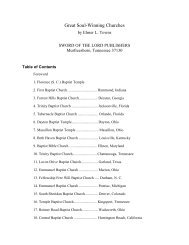The Names of Jesus - Elmer Towns
The Names of Jesus - Elmer Towns
The Names of Jesus - Elmer Towns
- TAGS
- elmer
- towns
- elmertowns.com
You also want an ePaper? Increase the reach of your titles
YUMPU automatically turns print PDFs into web optimized ePapers that Google loves.
3. <strong>The</strong> Word has active and personal communication with God (1:1,2).<br />
4. <strong>The</strong>re are two centers <strong>of</strong> consciousness, for the Word was God yet also was “face to face” or<br />
“with” God (1:1). 5. <strong>The</strong> Word has the essence <strong>of</strong> deity (1:1).<br />
6. <strong>The</strong> Father and the Word are one (1:1).<br />
7. <strong>The</strong> Word was he Agent by which God expressed or revealed Himself (1:18).<br />
8. <strong>The</strong> incarnate Word has a definite continuity with the preincarnate Word (1:1,14) .<br />
9. As God lived in a tent, spoke in a tent, and revealed Himself in the Old Testament tabernacle,<br />
so the Word tabernacled among us (1:14).<br />
10. <strong>The</strong> incarnation <strong>of</strong> the Word is the unique revelation <strong>of</strong> God (1:4).<br />
THE BELOVED<br />
<strong>The</strong> title “Beloved” occurs only once in Scripture (Ephesians 1:6), although many<br />
passages affirm the Father's love for the Son. God called <strong>Jesus</strong> “my beloved Son” at His baptism<br />
(Matthew 3:17), and <strong>Jesus</strong> repeatedly acknowledged that “the Father loveth the Son” (John 3:35;<br />
5:20; 17:23). Paul notes we are “accepted in the beloved” (Ephesians 1:6). <strong>The</strong> particularly<br />
comforting aspect <strong>of</strong> this title is the context in which it is revealed. <strong>Jesus</strong> is the object <strong>of</strong> the<br />
Father's love, and because we are in Christ, we too are the objects <strong>of</strong> the Father's love.<br />
THE IMAGE OF GOD<br />
<strong>The</strong> Greek word eikon, meaning “image,” is twice used in titles <strong>of</strong> Christ to express His<br />
unique relation to God. <strong>The</strong> word itself denotes an image and involves the two ideas <strong>of</strong> representation<br />
and manifestation. When Paul affirmed that <strong>Jesus</strong> is “the image <strong>of</strong> God” (II Corinthians<br />
4:4), he meant <strong>Jesus</strong> was essentially and absolutely the perfect representation and manifestation<br />
or expression <strong>of</strong> the Father. In another place Paul altered the title slightly by calling Christ “the<br />
image <strong>of</strong> the invisible God” (Colossians 1:15). It emphasizes that Christ is the visible<br />
representation and manifestation <strong>of</strong> God to created beings. Both contexts convey the idea <strong>of</strong><br />
perfection in that image.<br />
A second closely related title is “the express image <strong>of</strong> his person” (Hebrews 1:3). This is<br />
one <strong>of</strong> seven such statements in the early verses <strong>of</strong> Hebrews-all designed to demonstrate the<br />
superiority <strong>of</strong> Christ. Various versions translate it in different ways: “the very image <strong>of</strong> his<br />
substance” (ASV), “an exact representation <strong>of</strong> his very being” (Rhm), “flawless expression <strong>of</strong><br />
the nature <strong>of</strong> God” (Phillips), “stamped with God's own character” (M<strong>of</strong>fat), “the copy <strong>of</strong> his<br />
being” (Beck), “the exact representation <strong>of</strong> God's nature” (Swindoll), “the exact expression <strong>of</strong><br />
God's nature” (Stibbs), “the impress <strong>of</strong> the Divine Nature” (F.B. Meyer), and “the exact<br />
expression <strong>of</strong> God's very essence” (Barclay). This wide assortment <strong>of</strong> translations derives from<br />
two key Greek words in this title.<br />
<strong>The</strong>, first <strong>of</strong> these is the word character, which is closely related to the verb charasso,<br />
meaning “to cut, to scratch, or to mark.” Originally this word referred to a marking agent, such<br />
as a die, and then later to the impression made by the marking agent. It is similar to the English<br />
word “stamp,” which first referred to the instrument which printed the impression and later to the<br />
impression itself. It suggests the idea <strong>of</strong> an exact representation <strong>of</strong> the person or the person<br />
himself-that is, the distinguishing features or traits by which a person or thing is known (cf. the<br />
English word “characteristics”). What the writer <strong>of</strong> the Hebrews seems to argue by using this
















